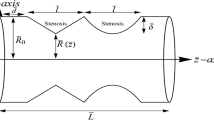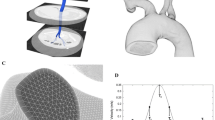Abstract
Numerical simulations are performed for two-dimensional steady and pulsatile flow of blood through a channel with single as well as double stenosis (with varying gap) under aortic conditions (Re = 4000). A shear-thinning model based on experimental data is used for blood. The governing equations are developed in terms of vorticity and stream function and solved using a finite difference scheme with full-multigrid algorithm. Peak wall shear stress increases with both length of stenosis, and gap between stenosis; however, the effect of increasing length is much more compared to gap. Pulsatility plays a key role by shifting the location of peak wall shear stress from the primary to the secondary stenosis, and back again, during a cycle. This result is of importance when developing a model for plaque growth based purely on mechanical factors.








Similar content being viewed by others
References
Anand, M., Rajagopal, K.R.: A shear-thinning viscoelastic fluid model for describing the flow of blood. Int J Cardiovasc Med Sci 4, 59–68 (2004)
Bodnar, T., Sequeira, A., Pirkl, L.: Numerical simulations of blood flow in a stenosed vessel under different flow rates using a generalized oldroyd-b model. Proceedings of AIP, Vol 1168, pp 645–648 (2009)
Chakravarty, S., Dutta, A.: Dynamic response of arterial blood flow in the presence of multi-stenoses. Math Comput Model 13, 37–55 (1990)
Chaturani, P., Ponnalagarsamy, R.: Pulsatile flow of Casson’s fluid through stenosed artery with applications to blood flow. Biorheology 23, 499–511 (1986)
Chien, S., Usami, S., Taylor, H.M., Lundberg, J.L., Gregersen, M.I.: Effects of hematocrit and plasma proteins on human blood rheology at low shear rates. J Appl Physiol 21(1), 81–7 (1966)
Deshpande, M.D., Giddens, D.P., Mabon, R.F.: Steady laminar flow through modeled vascular stenoses. J Biomech 9(4), 165–174 (1976)
Tang, D., Yang, C., Kobayashi, S., Ku, D.N.: Generalized finite difference method for 3-D viscous flow in stenotic tubes with large wall deformation and collapse. Appl Numer Math 38, 49–68 (2001)
Gould, K.L., Lipscomb, K.: Effects of coronary stenoses on coronary flow reserve and resistance. Am J Cardiol 34, 48–55 (1974)
Ikbal, M.A.: Viscoelastic blood flow through arterial stenosis–effect of variable viscosity. Int J Non-Linear Mech 47, 888–894 (2012)
David, NKu: Blood flow in arteries. Annu Rev Fluid Mech 29, 399–434 (1997)
Lee, T.S.: Numerical studies of fluid flow through tubes with double constrictions. Int J Numer Methods Fluids 11, 1113–1126 (1989)
MacDonald, D.A.: On steady flow through modeled vascular stenosis. J Biomech 12(1), 13–20 (1979)
Malek, A.M., Alper, L.S., Izumo, s: Hemodynamic shear stress and its role in atherosclerosis. J Am Med Assoc 282(21), 2035–2042 (1999)
Mandal, D.K., Manna, N.K., Chakrabarti, C.: Numerical study of blood flow through different double bell- shaped stenosed coronary artery during the progression of the disease, atherosclerosis. Int J Numer methods Heat Fluid Flow 6, 670–699 (2010)
Mandal, M.S., Mukhopadhyay, S., Layek, G.C.: Pulsatile flow of shear-dependent fluid in a stenosed artery. Theor Appl Mech 39, 209–231 (2012)
Mandal, P.K., Chakravarty, S., Mandal, A.: Numerical study of the unsteady flow of non-Newtonian fluid through differently shaped arterial stenoses. Int J Comput Math 84, 1059–1077 (2007)
Marieb, E.N.: Human Anatomy and Physiology. Pearson Education, Inc, 6th edition, (2006)
Moore, K.L.: Clinically oriented anatomy. Williams and Wilkins, Baltimore (1990)
Nadau, L., Sequeira, A.: Numerical simulations of shear dependent viscoelastic flows with a combined finite element-finite volume method. Comput Math Appl 53, 547–568 (2007)
Nichols, W.W., O’Rourke, M.F., Vlachopoulos, C., McDonald’s.: Blood Flow in Arteries: Theoretical, Experimental, and Clinical Principles, pages 48–53. CRC Press, Boca Raton, 6th edition, (2011)
NandaKumar, N., Sahu, K.C., Anand, M.: Blood flow in stenosed artery: a computational study. Hyderabad TS, India., 2014. (poster presentation)IUTAM symposium
NandaKumar, N., Kirti Chandra, Sahu, Anand, M.: Pulsatile flow of a shear-thinning fluid through a two-dimensional channel with a stenosis. Eur J Mech B-Fluid 49, 29–35 (2015)
Owens, R.G.: A new microstructure-based constitutive model for human blood. J Non-Newton Fluid Mech 140, 57–70 (2006)
Pincombe, B., Mazumdar, J.: The effects of post stenotic dilations on the flow of a blood analogue through stenosed coronary arteries. Math Comput Model 26(6), 57–70 (1997)
Pontrelli, G.: Pulsatile blood flow in a pipe. Comput Fluids 27, 367–380 (1998)
Pontrelli, G.: Blood flow through an axisymmetric stenosis. Proc Inst Mech Eng 215, 1–10 (2001)
Sabbah, H.N., Stein, P.D.: Hemodynamics of multiple versus single 50 percent coronary arterial stenoses. Am J Cardiol 50, 276–280 (1982)
Sahu, K.C.: Novel Stability problems in pipe flows. PhD thesis, JNCASR, Bangalore, Karnataka (2007)
Sankar, D.S., Hemalatha, K.: Pulsatile flow of Herschel-Bulkley fluid through stenosed arteries–a mathematical model. Int J Non-Linear Mech 41, 979–990 (2006)
Sarifuddin, Chakravarty, S., Mandal, P.K.: Effect of asymmetry and roughness of stenosis on non-Newtonian flow past an arterial segment. Int J Comput Methods 6, 361–388 (2009)
Stroud, J.S., Berger, S.A., Saloner, D.: Influence of stenosis morphology on flow through severely stenotic vessels: implications for plaque rupture. J Biomech 33(4), 443–455 (2000)
Tannehill, J.C., Anderson, D.A., Pletcher, R.H.: Computational fluid mechanics and heat transfer, 2nd edn. Taylor & Francis, Washington (1997)
Thurston, G.B.: Viscoelasticity of human blood. J Biophys 12, 1205–1217 (1972)
Tu, C., Deville, M., Dheur, L., Vanderschuren, L.: Finite-element simulation of pulsatile flow through arterial stenosis. J Biomech 25(10), 1141–1152 (1992)
Wille, S.O., Wallloe, L.: Pulsatile pressure and flow in arterial stenosis simulated in a mathematical model. J Biomed Eng 3, 17–24 (1981)
Yeleswarapu. K.K.: Evaluation of continuum models for characterizing the constitutive behavior of blood. PhD thesis, University of Pittsburgh, Pittsburgh, (1996)
Yeleswarapu, K.K., Kameneva, M.V., Rajagopal, K.R., Antaki, J.F.: The flow of blood in tubes: theory and experiment. Mech Res Comm 25, 257–262 (1998)
Acknowledgments
We thank Dr. Kirti Chandra Sahu for his valuable suggestions. NN was supported by the MHRD Fellowship for Research Scholars administered by IIT Hyderabad. We thank the Science and Engineering Research Board (SERB), of the Department of Science and Technology, for funding this work under the Fasttrack Scheme for Young Scientists Grant No. SR/FTP/ETA-16/2011.
Author information
Authors and Affiliations
Corresponding author
Rights and permissions
About this article
Cite this article
Nandakumar, N., Anand, M. Pulsatile flow of blood through a 2D double-stenosed channel: effect of stenosis and pulsatility on wall shear stress. Int J Adv Eng Sci Appl Math 8, 61–69 (2016). https://doi.org/10.1007/s12572-016-0165-2
Published:
Issue Date:
DOI: https://doi.org/10.1007/s12572-016-0165-2




